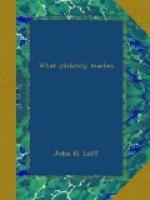[Illustration: Stamp, Egypt, 5 para]
How much of Egypt’s myths and splendors are here depicted; the temple column called Pompey’s pillar, the obelisk of Luxor, the mighty pyramids, last of all the sphynx, that fabled creature with the face of a woman, the body of a tigress and the heart of both. In fancy we can see her, crouched on a rock beside the great highway to Thebes, propounding her fatal riddle to the bewildered passers by, till Oedipus shall come.
[Illustration: Stamp, Turkey]
On the stamps and coins of Turkey we miss the portrait of the reigning sovereign, which we find on such issues of most monarchies. This is due to a law of Mohammed, which forbids the reproduction of the human figure. On the stamps we find the crescent, said to have been the emblem of the Byzantine empire and adopted by the Turks after the fall of Constantinople. We also find an elaborate device called the Toughra or signature of the Sultan. It owes its origin to the Sultan Murad I, a liberal sovereign and founder of many schools and institutions of learning but unable to write his own name. He signed imperial decrees by dipping his fingers in ink and placing them on the documents with three fingers close together and the little finger and thumb extended. In course of time this was adopted and, so to speak, consecrated as the signature of the Sultan. It was also elaborated and arranged to form a written phrase, while preserving, in a general way, its original form. The toughra contains certain characters which are permanent and minor ones which change. The latter are the names of the sovereign and his father. Thus the toughra which we illustrate reads: “His Majesty Abdul Hamid, son of Mejid, may he be always victorious.” The small inscription at the side reads “el ghazi,” the victorious, one of the titles of the Sultan. The toughra is often referred to as the hand. In an article published in 1867 I find the following on this subject:
[Illustration: [Arabic: El Ghazi]]
“The hand has to Mussulmen three mystic significations; it denotes providence; it is the expression of law; and thirdly, of power; it restores the courage of the faithful and strikes terror to the hearts of their enemies.
“As an emblem of law, the Mussulman thus explains the meaning of the hand. It has five fingers, each, with the exception of the thumb, having three joints, all the fingers are subordinate to the unity of the hand, their common foundation. The five fundamental precepts of the law are: 1st—Belief in God and his prophet. 2nd—Prayer. 3rd—Giving alms. 4th—Fasting during the sacred months and at the appointed times. 5th—Visiting the temples of Mecca and Medina. Each of these precepts admits of three divisions, except the first, symbolized by the thumb, which has only two, heart and work. These dogmas and their modifications have for their source the central doctrine of the unity of God; and all the creed of Mohametanism is contained in the hand,—the five fingers and their forty joints.




